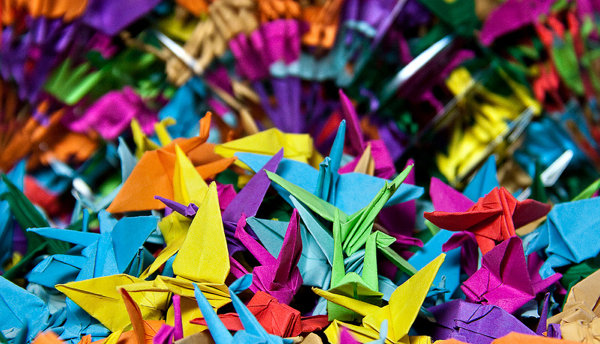You have no items in your cart. Want to get some nice things?
Go shopping
Aubrey Finkle once told his wife that Origami was an act of love, turning a simple sheet of paper into something with form and meaning. How fragile the paper shapes, how easy to flatten, so only the indelible creases are left to show anything had been made at all.
He took up Origami to fill the empty hours while Marianne energetically pursued her own interests. Horse riding, sculpture, painting and writing, knitting, swimming, modelling (clay and nude) and something, apparently, to do with car mechanics.
Aubrey began with the basic folds, following an old book bought at a bring-and-buy, propped open on the kitchen table, pages the colour of beer and liver-spotted. Tongue licking the edge of his moustache, glasses slipping, he would wrestle with little dishes and boats, hats, flowers and toads.
Two china blue paper butterflies (used, he explained to Marianne, during Shinto weddings to represent the bride and groom) were rescued by Aubrey from the recycling box, badly crushed, one with a shopping list blackening its wings.
Soon after that he phoned in sick. Stress-related, his work records showed. He used the free time to ride the bus into town each day and buy coloured paper, the texture of youthful skin, in a specialist stationers he had found.
As Aubrey’s ambition grew, so did his expertise. He made paper cranes, life-sized, suspending them from the kitchen ceiling in bright primary colours for when Marianne came back from a Yoga class. Unexplainedly tipsy, she swiped at them with a broom, like piñatas, bringing the birds down in a crumple of stiff feathers.
Aubrey moved his work to the study, spent weeks of work with thick, grey, waxy paper making a scaled down model of an elephant for the lounge. He stood by the window, sick with anticipation for her return. And when she did, hurrying between needlepoint and Salsa, she said nothing, just shook her head at the African ears and daringly erect trunk, then went to find her shoes. He wrestled the elephant upstairs and put it in the study with the nesting cranes.
Aubrey doubled his efforts, made a Noah’s Ark of animals in lemon paper to match the walls, then created a complex set of paper Russian dolls in the downstairs cloakroom, alternating between him and her. She donated them to the school. A replica of their home was placed in the garden. Inside, at a paper table, sat a him and a her. She mulched it with the spray from the garden hose.
Finally, one evening after a trip to the paper mill, Aubrey returned to find every piece of his Origami piled in the hallway, unfolded and smoothed flat. Marianne sat on the stairs, tight-skirted, bag packed.
The car mechanic, calling round when Marianne did not reply to his calls, found them later. Peeking through the letterbox he saw on the pile of flattened paper their bodies lying side-by-side, each one sliced with a thousand delicate paper cuts.

About Ken Elkes
KM Elkes is a prize-winning author, journalist and travel writer from Bristol, UK. Since starting to write fiction seriously in 2011 he has won the 2013 Fish Publishing flash prize, been shortlisted twice for the Bridport Prize in 2012-13 and is a finalist in the Aesthetica Creative Writing Award 2014. His work has also appeared in various anthologies and won prizes at Words With Jam, Momaya Review, Writing WM, Lightship Publishing, Aesthetica and Accenti in Canada.





The new #FlashFriday series for @litromagazine starts with a lovely story by @mysmalltales about marriage & origami: https://t.co/G4kfwUw1
@BillFaram Thanks for the retweet – #litromagazine a lovely story by @mysmalltales about marriage & origami: https://t.co/CYlkvxvi
#StorySunday “Paper Cuts” by @mysmalltales who is reading at #BristolFlash on @nationalflashfd https://t.co/kBE7JbqHTD